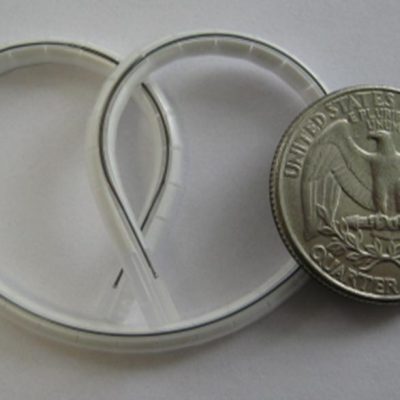A path to more efficient diagnoses

Disease diagnosis in hospitals today is a slow process. If a patient is suspected of having a life-threatening illness such as cancer, a biopsy is performed to excise tissue. If a lesion is found, the patient undergoes surgery to excise the disease. The disease tissue is sent to a pathology lab, where it is divided, put on slides, and then sent to a pathologist for analysis. Doctors—and patients—could wait weeks for results.
Current methods to provide a rapid assessment of excised tissue, such as X-ray specimen radiography, are expensive and limited in scope.
Technology could change all that, says Diana Mojahed, a postdoctoral fellow in Professor Juejun Hu’s lab and a 2023 recipient of the MIT’s entrepreneurial Kavanaugh Fellowship, which gives scientists training to commercialize their research.
Mojahed is working to miniaturize a form of microscopy called optical coherence tomography (OCT), an imaging test used in many clinical applications today that provides high-resolution images of tissue. Put on a silicon photonic chip and fitted into a medical device, the technology could be used to collect real-time images of a patient. It could also bypass the traditional surgery-to-lab-to-pathologist workflow, dramatically cutting down on time and cost.
“The majority of the microscope will be on the chip,” said Mojahed, whose PhD work at Columbia University was in optical microscopy. She was drawn to Hu’s lab for her postdoctoral training because of his development of a miniaturized spectrometer, a device for measuring wavelengths of light to determine the composition of materials—one component of the microscope. “I was interested in how we could use the discrete Fourier transform spectrometer as a building block to an on-chip microscope that can be used to image disease.”
The tools of entrepreneurship
Through the Kavanaugh Fellowship, Mojahed is working full-time to explore commercialization of the technology—learning how to turn a potential solution to a specific problem into a commercial product. She found the opportunity “at the perfect time.”
“I was ready to see if I could pursue a company to develop this product, as a supplement to my career which has been entirely research-focused,” Mojahed said. Before MIT, she designed an ultrahigh-speed OCT system for pathology imaging and performed a 100-patient clinical study. “I am dedicated to solving the problem of real-time imaging in pathology—and really excited about bringing the technology to life.”
Now she’s learning what it will take. The most important aspect is the finding the right team. “A good company needs people who are excited about what’s possible and understand the importance of their role in making it happen,” Mojahed said. “It’s critical for me to inspire the commitment of my team, because we are building a medical device that can have major implications for hospital workflow and patient care.”
Another business lesson she has learned is cultivating relationships with stakeholders. “It’s really important to listen to what the end user needs, what the payer is willing to pay for, and how your technology must fit into the larger picture of your industry’s landscape,” Mojahed said. “It’s important to find strong allies, through investors, partners, and beyond, and for there to be a strong fit in terms of how much they believe in your idea and you as a founder, and how much they’re willing to invest in you and the journey ahead.”
Technology, meet business
She’s still working on the technology itself. A traditional OCT device has many bulky components besides the spectrometer—a beam scanner, for example, which collects information about whatever’s being examined. All of it must be miniaturized and put on a chip. The new system will build on the groundbreaking silicon photonics research developed by the Hu lab. Over the course of the Kavanaugh Fellowship, Mojahed will advance the business development and technological work in parallel. After that, a startup could be imminent.
“If all goes well, I plan to launch my company at the end of 2023,” Mojahed said.
For Juejun Hu, Mojahed’s advisor, the potential benefit of her innovation to patients is incalculable.
“I believe that the project will not only advance our scientific understanding but also benefit society as a whole by offering an affordable and high-performance medical diagnostic technology,” Hu said.
In the meantime, Mojahed is adjusting to the dual role of scientific researcher and entrepreneur. For her, it’s a labor of love.
“I’ve always loved being a researcher, and if I work on a project, it’s because I really believe in the idea, and I truly pour my heart into it,” Mojahed said. “When thinking about starting a company, I’m excited because of the possibility of bringing valuable technology into practice and improving patients’ lives.”

